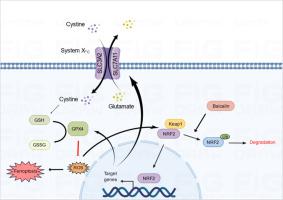Phytomedicine ( IF 6.7 ) Pub Date : 2023-05-13 , DOI: 10.1016/j.phymed.2023.154881 Rui-Jia Wen 1 , Xin Dong 2 , Hao-Wen Zhuang 3 , Feng-Xiang Pang 3 , Shou-Chang Ding 3 , Nan Li 3 , Yong-Xin Mai 3 , Shu-Ting Zhou 3 , Jun-Yan Wang 4 , Jin-Fang Zhang 5

|
Background
Osteosarcomas (OS) is a kind of malignant bone tumor which occurs primarily in children and adolescents, and the clinical therapeutics remain disappointing. As a new programmed cell death, ferroptosis is characterized by iron dependent and intracellular oxidative accumulation, which provides a potential alternative intervene for the OS treatment. Baicalin, a major bioactive flavone derived from traditional Chinese medicine Scutellaria baicalensis, has been proved to have anti-tumor properties in OS. Whether ferroptosis participated in the baicalin mediated anti-OS activity is an interesting project.
Purpose
To explore the pro-ferroptosis effect and mechanisms of baicalin in OS.
Methods/study design
Pro-ferroptosis effect of baicalin on cell death, cell proliferation, iron accumulation, lipid peroxidation production was determined in MG63 and 143B cells. The levels of glutathione (GSH), oxidized (GSSG) glutathione and malondialdehyde (MDA) were determined by enzyme linked immunosorbent assay (ELISA). The expression levels of nuclear factor erythroid 2-related factor 2 (Nrf2), Glutathione peroxidase 4 (GPX4) and xCT were detected by western blot in baicalin-mediated ferroptosis regulation. In vivo, a xenograft mice model was adopted to explore the anticancer effect of baicalin.
Results
In the present study, it was found that baicalin significantly suppress tumor cell growth in vitro and in vivo. By promoting the Fe accumulation, ROS formation, MDA production and suppressing the ratio of GSH/GSSG, baicalin was found to trigger ferroptosis in OS and ferroptosis inhibitor ferrostatin-1 (Fer-1) successfully reversed these suppressive effects, indicating that ferroptosis participated in the baicalin mediated anti-OS activity. Mechanistically, baicalin physically interacted with Nrf2, a critical regulator of ferroptosis, and influenced its stability via inducing ubiquitin degradation, which suppressed the Nrf2 downstream targets GPX4 and xCT expression, and led to stimulating ferroptosis.
Conclusions
Our findings for the first time indicated that baicalin exerted anti-OS activity through a novel Nrf2/xCT/GPX4-dependent ferroptosis regulatory axis, which hopefully provides a promising candidate for OS treatment.
中文翻译:

黄芩苷通过新的 Nrf2/xCT/GPX4 调控轴诱导骨肉瘤铁死亡
背景
骨肉瘤(OS)是一种主要发生在儿童和青少年的恶性骨肿瘤,临床治疗效果令人失望。作为一种新的程序性细胞死亡,铁死亡的特点是铁依赖性和细胞内氧化积累,这为 OS 治疗提供了一种潜在的替代干预。黄芩苷是一种主要的生物活性黄酮,来源于传统中药黄芩,已被证明在 OS 中具有抗肿瘤特性。ferroptosis 是否参与黄芩苷介导的抗 OS 活性是一个有趣的项目。
目的
探讨黄芩苷在OS中的促铁死亡作用及其机制。
方法/研究设计
在 MG63 和 143B 细胞中测定了黄芩苷对细胞死亡、细胞增殖、铁积累、脂质过氧化产生的促铁死亡作用。谷胱甘肽 (GSH)、氧化型 ( GSSG ) 谷胱甘肽和丙二醛 (MDA)的水平通过酶联免疫吸附测定 ( ELISA)测定。在黄芩苷介导的铁死亡调节中,通过蛋白质印迹检测核因子红细胞 2 相关因子 2 (Nrf2)、谷胱甘肽过氧化物酶 4 (GPX4) 和 xCT 的表达水平。在体内,采用异种移植小鼠模型探讨黄芩苷的抗癌作用。
结果
在本研究中,发现黄芩苷在体外和体内显着抑制肿瘤细胞生长。通过促进 Fe 积累、ROS 形成、MDA 产生和抑制 GSH/GSSG 的比例,发现黄芩苷可引发 OS 中的铁死亡,而铁死亡抑制剂 ferrostatin-1 (Fer-1) 成功逆转了这些抑制作用,表明铁死亡参与了黄芩苷介导的抗 OS 活性。从机制上讲,黄芩苷与铁死亡的关键调节因子 Nrf2 发生物理相互作用,并通过诱导泛素降解影响其稳定性,从而抑制 Nrf2 下游靶标 GPX4 和 xCT 的表达,并导致刺激铁死亡。
结论
我们的研究结果首次表明黄芩苷通过一种新型的 Nrf2/xCT/GPX4 依赖性铁死亡调节轴发挥抗 OS 活性,有望为 OS 治疗提供一个有希望的候选药物。











































 京公网安备 11010802027423号
京公网安备 11010802027423号